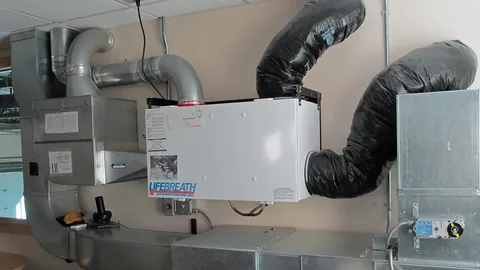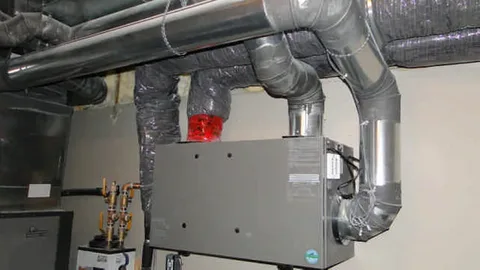Indoor air quality is a crucial aspect of our overall health and well-being. Unfortunately, the air inside our homes can often be more polluted than the air outside. This is where the HRV Heat Recovery Ventilator comes in. This innovative system is designed to efficiently and effectively exchange stale indoor air with fresh outdoor air, all while retaining the heat or coolness in your home. It creates a healthy, fresh and comfortable environment for the dwellers.
Understanding the Basics of a Best Heat Recovery Ventilator
The efficiency of an HRV is measured by its heat recovery rate, indicating the percentage of heat transferred from the outgoing stream to the incoming one. Selecting the best heat recovery ventilator involves considering factors like its recovery rate, size capacity for your home, and overall energy consumption, ensuring that it meets your specific needs for enhancing indoor air quality and energy efficiency.
This process is facilitated by a heat exchange core, where the two streams of air pass each other, separated by a thin barrier that prevents them from mixing but allows the transfer of heat. This mechanism ensures that the fresh air entering your home is pre-conditioned, reducing the load on your heating and cooling system.
Consequently, not only does this promote healthier indoor air quality, but it also results in significant energy savings due to the lowered heating and cooling demand. This ultimately enhances the sustainability and comfort of your home environment. In turn, this results in decreased utility bills and a minimized carbon footprint. Importantly, an HRV system provides an optimal solution to issues of indoor condensation, helping to prevent structural damage and potential health problems associated with dampness and mold.
 Enhancing Indoor Air Quality with Heat Recovery Ventilator
Enhancing Indoor Air Quality with Heat Recovery Ventilator
The role of the Heat Recovery Ventilator in enhancing indoor air quality cannot be overstated. By continuously exchanging the stale, contaminated air inside your home with fresh, outdoor air, an HRV plays a pivotal role in reducing pollutants, allergens, and excess moisture that can contribute to mold growth and poor air quality.
This constant renewal of air ensures that harmful chemicals from cleaning products, off-gassing from furniture, and other indoor pollutants are significantly diminished. Moreover, the HRV’s capability to maintain an optimal balance of humidity levels further contributes to a healthier living environment.
This balanced humidity level is crucial not only for comfort but also for preventing conditions that can exacerbate respiratory issues, allergies, and other health concerns. By integrating an Heat-Recovery Ventilator into your home, you’re taking a proactive step towards safeguarding the health of your living space, making it a sanctuary of clean, fresh air that supports the well-being of everyone who resides there.
Energy Recovery Ventilator: A Key to Energy Efficiency
While the HRV focuses on heat exchange, an Energy Recovery Ventilator (ERV) goes a step further by managing both temperature and moisture levels, offering an advanced solution for energy efficiency in homes. Similar to HRVs, ERVs exchange indoor and outdoor air, but they also transfer moisture along with heat, making them particularly beneficial in areas with extreme weather conditions, either very humid or very dry.
By retaining the desired humidity levels and pre-conditioning the incoming air, ERVs reduce the strain on HVAC systems, leading to significant energy savings. The ability of an ERV to balance humidity ensures a comfortable indoor environment without the excessive use of air conditioners or heaters.
This dual action of controlling temperature and moisture not only enhances the home’s energy efficiency but also contributes to a healthier indoor air quality by preventing the conditions that allow mold and mildew to thrive. Implementing an ERV system is a proactive approach towards achieving optimal energy conservation and maximizing the comfort and health of indoor spaces.
Combating Humidity and Enhancing Comfort with HRV
One of the lesser-known yet highly impactful benefits of the Recovery Ventilator is its ability to manage indoor humidity levels, thereby enhancing the comfort of your home environment. In regions where the air is either too moist or too dry, maintaining a consistent and comfortable humidity level can be challenging.
Excess humidity can lead to a sticky, uncomfortable atmosphere, and potentially encourage mold and mildew growth, while too little humidity can cause dry skin, irritation, and discomfort. The HRV system adeptly addresses these concerns by exchanging the moist, stale indoor air with fresh, drier air from outside.
Additionally, during the colder months, when indoor air tends to be drier due to heating, the HRV’s heat exchange process adds moisture to the incoming air, preventing the overly dry conditions that can be uncomfortable for inhabitants. This dynamic adjustment to indoor air moisture levels, without a significant loss of energy, underscores the HRV’s role not just in purifying indoor air but in creating a more comfortable, humidity-balanced environment for residents.
Extending the Lifespan of Your HVAC System with HRV
One of the unsung benefits of integrating a Recovery Ventilator into your home is its positive impact on the longevity of your HVAC (Heating, Ventilation, and Air Conditioning) system. By preconditioning the incoming air, the HRV significantly reduces the workload on your HVAC unit. During the colder months, the HRV captures and recycles the heat from the outgoing air, delivering warm air into your home without engaging the heating system excessively.
Similarly, in warmer periods, the cooler, fresh air introduced by the HRV means less reliance on air conditioning to maintain a comfortable indoor temperature. This reduction in demand not only decreases wear and tear but also translates into fewer maintenance issues and repairs over time.
Consequently, the HRV system acts as a protective ally for your HVAC system, enhancing its efficiency and potentially extending its operational lifespan. This synergy not only supports a sustainable living environment but also provides financial savings through reduced energy consumption and decreased need for HVAC system replacements or extensive repairs.
How HRV Systems Contribute to a Greener Planet
Recovery Ventilators play a pivotal role in promoting environmental sustainability. By enhancing energy efficiency in homes, these systems significantly reduce the carbon footprint associated with heating and cooling. The process of recycling heat from the exhaust air decreases the energy demand on HVAC systems, which typically rely on fossil fuels or electricity, resources that contribute to greenhouse gas emissions when produced.
Furthermore, the reduction in energy consumption aligns with global efforts to mitigate climate change by lessening the reliance on non-renewable energy sources. HRV systems also contribute to a healthier indoor environment by reducing pollutants and moisture levels, which can decrease the need for chemical-based air fresheners and dehumidifiers, further reducing the home’s ecological impact.
By incorporating HRV technology, homeowners take an active step towards conserving natural resources and supporting a more sustainable, eco-friendly lifestyle. This contribution to a greener planet illustrates the essential role of HRV systems not only in enhancing individual home environments but also in advancing broader environmental goals. To truly reap the benefits of HRV systems, homeowners must understand how to properly operate and maintain these systems.
Installing an HRV Recovery Ventilator system may seem daunting, but with proper planning and understanding, it can be smoothly integrated into any home. The first step is to consult with a qualified HVAC professional who has experience with HRV systems. They can assess your home’s specific needs, considering factors like the size of your home, the local climate, and your family’s air quality requirements. It’s crucial to choose a system that fits your home’s layout and ductwork configuration to ensure optimal performance.
Once the right model has been selected, installation involves connecting the HRV system to your home’s existing heating and cooling system, ensuring that the airflows are correctly balanced for efficient operation. The vents for extracting stale air and introducing fresh air are strategically placed to maximize air quality and energy efficiency.
A professional installer will also guide you through the initial settings and how to maintain your system for long-term success. Remember, while the upfront investment and installation process may require time and resources, the long-term health, comfort, and energy savings benefits of an HRV system make it a worthwhile addition to any home. With its superior technology, an HRV system is not just a simple ventilator; it’s an investment towards a healthier and more efficient living environment. Let’s dive into understanding more about its various components and their role in promoting better indoor air quality.
Best Energy Recovery Ventilator is here to Stay
The trend towards building tighter, more energy-efficient homes has elevated the role of ventilation systems, particularly the Best Energy Recovery Ventilator (ERV). This system stands out for its sophisticated technology that not only exchanges stale indoor air with fresh outdoor air but also balances humidity and conserves energy. The ERV’s ability to manage both moisture and temperature has made it indispensable in modern sustainable construction.
As homeowners become increasingly aware of the importance of indoor air quality and its impact on health, the demand for ERVs continues to grow. This growing demand is backed by advancements in ERV technology, making these systems more efficient, affordable, and adaptable to various climates and home sizes.
The ERV’s contribution to reducing energy consumption, alongside its capability to improve air quality, aligns with the global shift towards greener, more sustainable living practices. With these compelling benefits, it’s clear that the ERV is not just a temporary solution but a key component of future home ventilation strategies, ensuring it’s here to stay in the pursuit of healthier, more energy-efficient homes.
FAQS
What Is The Difference Between An HRV And An ERV?
An HRV (Heat0Recovery Ventilator) primarily focuses on heat exchange between incoming and outgoing air streams, while an ERV (Energy-Recovery Ventilator) also facilitates moisture transfer, making it more suitable for extreme climates by managing humidity levels.
How Often Does an HRV/ERV System Need Maintenance?
Regular maintenance, including filter changes and system checks, is recommended at least every six months to ensure optimal performance and longevity of the system.
Can An HRV System Reduce Energy Bills?
Yes, by pre-conditioning incoming air and reducing the demand on heating and cooling systems, an HRV can contribute to lower energy consumption and potentially reduce utility bills.
Conclusion
In wrapping up our discussion on the pivotal role of HRV Heat Recovery Ventilators and Energy-Recovery Ventilators in modern homes, it’s clear that these systems offer more than just improved air quality they represent a step forward in sustainable living and energy efficiency. By choosing to install an HRV or ERV, homeowners are making a commitment not only to their family’s health but also to the health of our planet. These systems, by reducing energy consumption and improving indoor air quality, align with the growing trend towards eco-friendly living practices.
This article was first published on:
The HRV Heat Recovery Ventilator: A Must-Have in Every Home
| Other Good Articles to Read |
| unreal blogs |
| tba blogs |
| all city forums |
| dany blogs |
| refuge blogs |
| the music blogs |
| key forums |
| the big blog theory |
| joe blogs |
| blogs 4 me |
| Blogs Emon |
| Related Business Listings |
| Contact Directory |
| Local Business Profiles |

